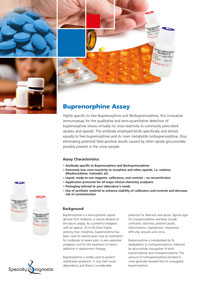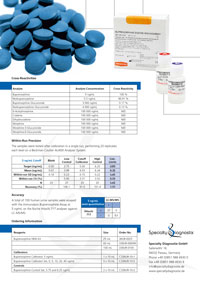When compliance testing is the main goal of an application, getting an accurate screening result for Buprenorphine is crucial.
Highly specific to free Buprenorphine and Norbuprenorphine, this innovative immunoassay for the qualitative and semi-quantitative detection of buprenorphine shows virtually no cross-reactivity to commonly prescribed opiates and opioids.
The antibody employed binds specifically and almost equally to free buprenorphine and its main metabolite norbuprenorphine.
The Immunalysis HEIA™ Buprenorphine assay shows an excellent performance with respect to precision (CVs < 6 %), linearity (R = 0,9995) and sensitivity (sensitivity limit = 0.32 ng/mL) on the Beckman Coulter AU400 analyser system.
The assay provides an adequately sensitive and specific screening for buprenorphine in urine samples at a cut-off concentration of 5 ng/mL.






